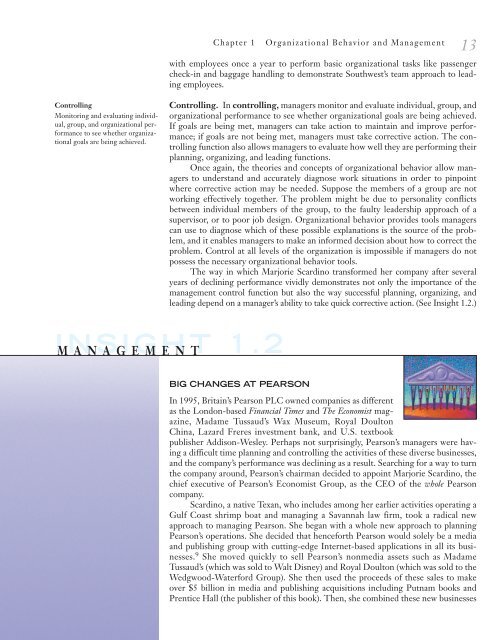chapter - Pearson
chapter - Pearson
chapter - Pearson
You also want an ePaper? Increase the reach of your titles
YUMPU automatically turns print PDFs into web optimized ePapers that Google loves.
Chapter 1<br />
Organizational Behavior and Management<br />
13<br />
with employees once a year to perform basic organizational tasks like passenger<br />
check-in and baggage handling to demonstrate Southwest’s team approach to leading<br />
employees.<br />
Controlling<br />
Monitoring and evaluating individual,<br />
group, and organizational performance<br />
to see whether organizational<br />
goals are being achieved.<br />
Controlling. In controlling, managers monitor and evaluate individual, group, and<br />
organizational performance to see whether organizational goals are being achieved.<br />
If goals are being met, managers can take action to maintain and improve performance;<br />
if goals are not being met, managers must take corrective action. The controlling<br />
function also allows managers to evaluate how well they are performing their<br />
planning, organizing, and leading functions.<br />
Once again, the theories and concepts of organizational behavior allow managers<br />
to understand and accurately diagnose work situations in order to pinpoint<br />
where corrective action may be needed. Suppose the members of a group are not<br />
working effectively together. The problem might be due to personality conflicts<br />
between individual members of the group, to the faulty leadership approach of a<br />
supervisor, or to poor job design. Organizational behavior provides tools managers<br />
can use to diagnose which of these possible explanations is the source of the problem,<br />
and it enables managers to make an informed decision about how to correct the<br />
problem. Control at all levels of the organization is impossible if managers do not<br />
possess the necessary organizational behavior tools.<br />
The way in which Marjorie Scardino transformed her company after several<br />
years of declining performance vividly demonstrates not only the importance of the<br />
management control function but also the way successful planning, organizing, and<br />
leading depend on a manager’s ability to take quick corrective action. (See Insight 1.2.)<br />
INSIGHT M A N A G E M E N T 1.2<br />
BIG CHANGES AT PEARSON<br />
In 1995, Britain’s <strong>Pearson</strong> PLC owned companies as different<br />
as the London-based Financial Times and The Economist magazine,<br />
Madame Tussaud’s Wax Museum, Royal Doulton<br />
China, Lazard Freres investment bank, and U.S. textbook<br />
publisher Addison-Wesley. Perhaps not surprisingly, <strong>Pearson</strong>’s managers were having<br />
a difficult time planning and controlling the activities of these diverse businesses,<br />
and the company’s performance was declining as a result. Searching for a way to turn<br />
the company around, <strong>Pearson</strong>’s chairman decided to appoint Marjorie Scardino, the<br />
chief executive of <strong>Pearson</strong>’s Economist Group, as the CEO of the whole <strong>Pearson</strong><br />
company.<br />
Scardino, a native Texan, who includes among her earlier activities operating a<br />
Gulf Coast shrimp boat and managing a Savannah law firm, took a radical new<br />
approach to managing <strong>Pearson</strong>. She began with a whole new approach to planning<br />
<strong>Pearson</strong>’s operations. She decided that henceforth <strong>Pearson</strong> would solely be a media<br />
and publishing group with cutting-edge Internet-based applications in all its businesses.<br />
9 She moved quickly to sell <strong>Pearson</strong>’s nonmedia assets such as Madame<br />
Tussaud’s (which was sold to Walt Disney) and Royal Doulton (which was sold to the<br />
Wedgwood-Waterford Group). She then used the proceeds of these sales to make<br />
over $5 billion in media and publishing acquisitions including Putnam books and<br />
Prentice Hall (the publisher of this book). Then, she combined these new businesses

















